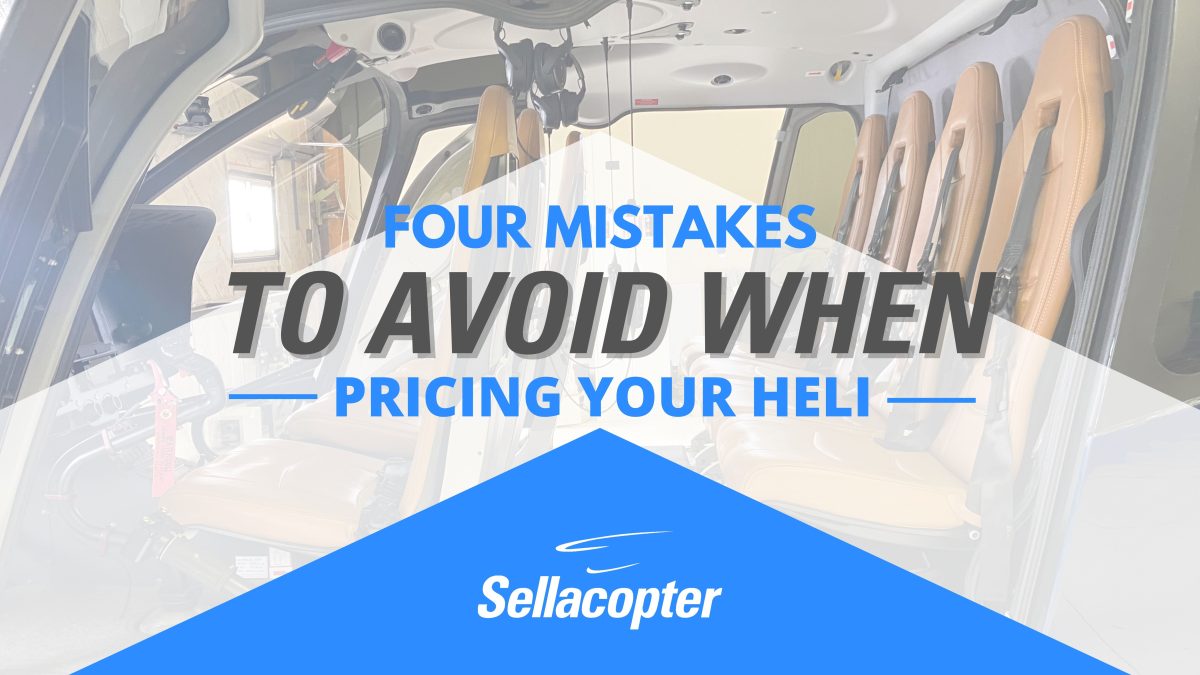- Sellacopter - List it. Sell it. Done.
- 1-855-SELLACOPTER


Four mistakes to avoid when pricing your helicopter.
Four Mistakes to Avoid When Pricing Your Helicopter
Four Mistakes to Avoid When Pricing Your Helicopter
Is this happening to you? Your helicopter has sat idle for a while and you’ve been asking yourself:
“My helicopter has always been hangered, I take great care of it, and there’s no damage history! Come to think of it, my helicopter is the nicest machine on the market, possibly in the world! But how much is it worth?”
If I had a dime for every time a seller said something similar, I suppose I wouldn’t have to be in helicopter sales – I’d be a rich man! Since we’re picky about the helicopters we’ll represent, most of the time our sellers are on to something. The helicopters we have are: well maintained, present well, and they check most of the preferable “buyer boxes.” However, that doesn’t mean the listing price you have in your head is entirely accurate or even close. That’s why you should understand these:
Top four pricing misconceptions:
- I purchased my helicopter at retail, flew the machine for 300 hours, and now I want to turn a profit.
- I’ve spent at least $100,000 in the past four years maintaining the helicopter. I am definitely going to recoup those costs.
- Looking online, my helicopter’s comparable listings place my asking price at “X.”
- I want to list high, so I have room to negotiate down.
- The retail misconception
Whether you’ve purchased your helicopter brand new from the factory or bought it used for retail, after you have flown the machine, in most cases, the resale value is going to be less than what you paid. Why? According to Robert Kiyosaki, author of Rich Dad Poor Dad, the helicopter itself is a liability, not an asset. An operator that makes money from using the aircraft is making money on the operation, not the potential resale of the machine. But there’s good news for tax purposes: the helicopter is a liability that depreciates every hour you fly the aircraft. When listing your helicopter, be sure to understand the rate at which your make and model helicopter depreciates per flight hour. Not all airframes carry the same depreciation figure.
- The maintenance misconception
I wish we had a cool acronym like our water-dwelling cousin, the BOAT: “Bust Out Another Thousand.” Like a boat, a helicopter can and will be typically very unforgiving for ongoing maintenance to maintain airworthiness. No matter what you do, your annual inspection will always cost more than you planned. A large ticket item like the HMU won’t make it to TBO. If it can break, it will! When selling, buyers do not see the value of the money you’ve had to pay for continued airworthiness. Effectively, it’s seen as cost of ownership. Nine times out of ten, the maintenance you do and the parts you replace don’t reflect dollars and cents when it comes time to sell. With new parts, you can argue they add value, but your expectation should be 20% of the MSRP of the part, not dollar for dollar.
- The listing misconception
Looking at comparable aircraft to help formulate your pricing strategy is sound logic. Still, if the figures on which you’re basing your selling price are not in line with actual market values, then you’ll quickly land yourself in listing purgatory. When looking online at listings placed on large platforms, the asking prices are usually out-of-touch with reality. If you’re using these listing values to determine your listing price, you will join the long line of aircraft that will never sell. Aircraft will sit over-priced, sometimes well over one year, at which point the seller realizes that no one is calling, a significant price drop will occur, and the aircraft will finally sell. Here are the current “time on market” figures for some frequently bought and sold helicopter makes and models.
Robinson R44: 7 Months / Robinson R66: 10.3 Months
Airbus H125: 8.5 Months / Airbus H130: 6.7 Months
Bell 407: 12 Months
For reference, when priced within FMV (fair market value), a helicopter should have multiple offers within the first four weeks.
- The pricing misconception
If you think you can list your helicopter intentionally high so that you can negotiate down, think again. Listing high can almost guarantee that your phone will not ring. Most buyers are either educated operators or private buyers with knowledgeable representation. When looking at on-market aircraft, if I come across an R44 listed 100K over FMV or a Bell 407 that is 250K above – I’m moving on to the next listing because what’s the point of vetting an EXTREMELY OVERPRICED aircraft?
In my experience, these four “misconceptions” end up being four mistakes sellers make when listing and determining their pricing strategy. Next month we’ll dive deep into how you can avoid these pricing mistakes, and benefit from our systematic approach to listing and pricing your aircraft.
